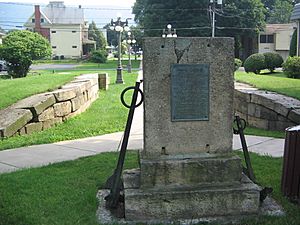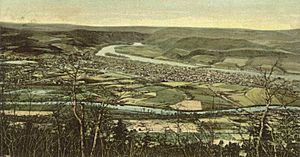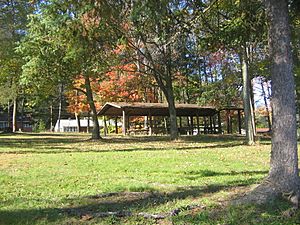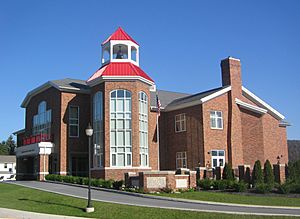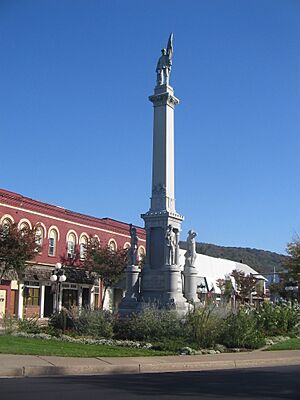Lock Haven, Pennsylvania facts for kids
Quick facts for kids
Lock Haven, Pennsylvania
|
||
|---|---|---|
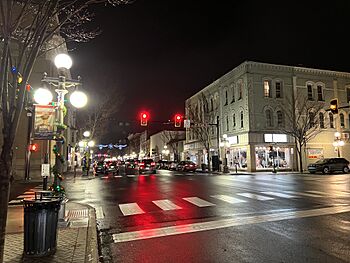
Downtown Lock Haven at night at the intersection of East Main Street and North Grove Street
|
||
|
||

Location of Lock Haven in Clinton County, Pennsylvania (right) and of Clinton County in Pennsylvania (left)
|
||
| Country | United States | |
| State | Pennsylvania | |
| County | Clinton County | |
| Settled | 1769 | |
| Incorporated (borough) | 1844 | |
| Incorporated (city) | 1870 | |
| Government | ||
| • Type | Council-Manager | |
| Area | ||
| • Total | 2.67 sq mi (6.91 km2) | |
| • Land | 2.50 sq mi (6.47 km2) | |
| • Water | 0.17 sq mi (0.44 km2) 6.44% | |
| Elevation | 561 ft (171 m) | |
| Population
(2020)
|
||
| • Total | 8,108 | |
| • Density | 3,248.40/sq mi (1,254.00/km2) | |
| Time zone | UTC-5 (EST) | |
| • Summer (DST) | UTC-4 (EDT) | |
| ZIP Code |
17745
|
|
| Area code(s) | 570 and 272 | |
| FIPS code | 42-44128 | |
| Website | (government) (civil) |
|
Lock Haven is a city in Pennsylvania, USA. It is the main city of Clinton County. The city is located where the West Branch Susquehanna River and Bald Eagle Creek meet. In 2020, about 8,108 people lived there.
Lock Haven started in 1833 as a town for the timber industry. It was a safe place for loggers and boatmen. The city grew quickly because of its natural resources and good transportation. In the 20th century, a factory that made small airplanes, a college, and a paper mill helped the economy.
The city has faced many floods, especially a big one in 1972. This flood hurt local businesses and caused many people to lose their jobs in the 1980s. To protect the city, a large wall (levee) was built in 1995. Today, many people in Lock Haven work in education, healthcare, or social services.
Lock Haven has three important historical sites. These are the Memorial Park Site, an ancient Native American area; Heisey House, a museum from the Victorian era; and the Water Street District, which has many old buildings.
Contents
Exploring Lock Haven's Past
Early History of Lock Haven
The first people in Pennsylvania arrived a very long time ago, between 12,000 and 8,000 BCE. They came when the ice from the Ice Age was melting. At the Memorial Park Site near Lock Haven, archaeologists have found tools and items from these early people. These finds show that people lived here for about 8,000 years.
Around the 1700s, the Iroquois Native American group controlled the tribes in Pennsylvania. This included the Munsee people who lived on Great Island near Lock Haven. Several important Native American trails crossed this island. During the French and Indian War (1754–63), colonial soldiers destroyed Munsee homes. By 1763, the Munsee had left their villages in the area.
In 1768, the British made a treaty with the Iroquois. This gave the British control of lands south of the West Branch River. However, European settlers still moved onto land that was not part of the treaty, including the future site of Lock Haven.
Settlers Arrive and Forts are Built
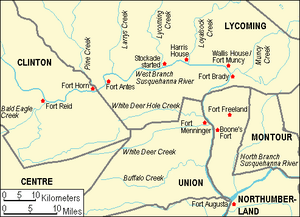
The first European settler, Cleary Campbell, built a log cabin here in 1769. By 1773, William Reed built a small fort called Reed's Fort. This fort was one of 11 forts along the West Branch River. During the American Revolution (1775–83), Native Americans, encouraged by the British, attacked settler homes.
In 1778, many settlers, including those at Fort Reed, had to leave their homes. This event was called the Big Runaway. They fled to Fort Augusta, about 50 miles away. Some did not return for five years. In 1784, another treaty with the Iroquois gave most of the remaining Native American land in Pennsylvania to the United States.
Lock Haven in the 1800s
Lock Haven was officially planned as a town in 1833. It became the county seat in 1839. The city grew rich in the 1800s mostly because of timber and transportation. The forests nearby had huge amounts of trees like white pine and hemlock. These trees were used for houses, boats, and even ship parts. Loggers floated whole logs down the river to sawmills.
The West Branch Canal opened in 1834. It connected Lock Haven to other towns. Lock Haven's founder, Jeremiah Church, chose the town site because of the river, the creek, and the canal. He named the town Lock Haven because it had a canal lock and was a safe place (a "haven") for travelers. The canal helped Lock Haven's population grow quickly.
In 1849, a large log boom was built in Lock Haven. This was a system of piers and timbers that held floating logs in the river. Workers sorted the logs, which were branded like cattle, and sent them to sawmills. Lock Haven became a major center for the lumber business.
The Philadelphia and Erie Railroad arrived in Lock Haven in 1859. This led to a building boom. People hoped the area's coal, iron, and clay would bring wealth. Although some early business ideas failed, the railroad provided a new way to transport timber. Another railroad line, the Bald Eagle Valley Railroad, connected Lock Haven to Tyrone in the 1860s.
Sometimes, logs would get stuck in the river, causing huge logjams. In 1874, a large log raft got stuck in a dam chute. This caused a jam that blocked the river with logs 16 feet high. The lumber industry in Pennsylvania started to decline around 1885. Flooding in 1889 badly damaged the canals and destroyed the log boom, which also hurt Lock Haven's timber business.
The Central State Normal School, which trained teachers, opened in 1877. This school later became Lock Haven University of Pennsylvania. A paper mill also opened nearby in the early 1880s and was a big employer for many years.
Lock Haven in the 1900s
As canals disappeared, new ways to travel appeared. Electric trolleys started running in Lock Haven in 1894. These trolleys carried passengers between Lock Haven and Mill Hall. However, after World War I, cars and buses became more popular. The trolley system stopped running around 1930.
William T. Piper Sr. built the Piper Aircraft factory in Lock Haven in 1937. The company made small airplanes like the Piper Cub. Piper Aircraft was a major employer in the city until 1984, when it moved to Florida. The Piper Aviation Museum opened in 1985 at the old factory site.
The Central State Normal School became Lock Haven State Teachers College in 1927. It grew a lot between 1942 and 1970, with many more students and teachers. The school changed its name to Lock Haven University of Pennsylvania in 1983.
In 1982, an industrial area near Lock Haven was listed as a Superfund site. This meant it had hazardous waste that needed cleaning up. A company called Drake Chemical had made chemicals there. The United States Environmental Protection Agency started cleaning the site in 1982, removing contaminated soil and treating groundwater.
Major Floods in Lock Haven

Pennsylvania rivers have often flooded. Major floods happened in the Susquehanna River in 1784, 1865, 1889, 1894, 1902, 1936, and 1972. In Lock Haven, there were 19 floods between 1847 and 1979. The biggest flood was on March 18, 1936. The river rose about 11 feet above flood stage.
The flood on June 1, 1889, was also very big. It destroyed Lock Haven's log boom, and millions of feet of timber were washed away. This flood also damaged the canals, which were then abandoned.
The most damaging flood in Lock Haven happened in 1972. It was caused by the remains of Hurricane Agnes. The storm brought heavy rains, up to 19 inches in some areas. In Lock Haven, the river rose very high, almost as high as in 1936. This flood badly damaged the paper mill and Piper Aircraft.
To prevent future damage, a large levee and flood wall were built around the city. This project was finished in 1995. The levee has protected Lock Haven from high water during storms like the Blizzard of 1996 and Hurricane Ivan in 2004.
Lock Haven's Location and Environment
Lock Haven is the main city of Clinton County. The city covers about 2.7 square miles, with most of it being land and a small part being water.
Lock Haven is about 561 feet above sea level. It is located where Bald Eagle Creek meets the West Branch of the Susquehanna River. The city is about 200 miles northwest of Philadelphia and 175 miles northeast of Pittsburgh. Major roads like U.S. Route 220 and Pennsylvania Route 120 pass through or near the city.
The city is in a valley surrounded by mountains. Bald Eagle Mountain runs along the south side of the city. The area has different types of rocks, mostly limestone in the southeast and siltstone and shale to the north and west. While much of the city is flat, there are slopes, especially near the river and the university.
Lock Haven's Climate
Lock Haven has a humid continental climate. This means it has hot summers and cold winters. The average temperature in January is 28°F (about -2°C), and in July it is 73°F (about 23°C). The highest temperature ever recorded was 106°F (41°C) in 1936. The lowest was -22°F (-30°C) in 1912.
June is usually the wettest month. The city gets about 39 inches of rain each year. Snowfall varies, but the most recorded in one month was 38 inches in April 1894.
| Climate data for Lock Haven, Pennsylvania (1926–1977, extremes 1888–1996) | |||||||||||||
|---|---|---|---|---|---|---|---|---|---|---|---|---|---|
| Month | Jan | Feb | Mar | Apr | May | Jun | Jul | Aug | Sep | Oct | Nov | Dec | Year |
| Record high °F (°C) | 71 (22) |
75 (24) |
86 (30) |
97 (36) |
102 (39) |
104 (40) |
105 (41) |
106 (41) |
103 (39) |
93 (34) |
84 (29) |
70 (21) |
106 (41) |
| Mean daily maximum °F (°C) | 36.3 (2.4) |
38.3 (3.5) |
48.6 (9.2) |
62.7 (17.1) |
74.5 (23.6) |
82.3 (27.9) |
86.4 (30.2) |
84.0 (28.9) |
76.9 (24.9) |
65.3 (18.5) |
51.0 (10.6) |
38.6 (3.7) |
62.3 (16.8) |
| Daily mean °F (°C) | 27.9 (−2.3) |
28.9 (−1.7) |
37.9 (3.3) |
49.7 (9.8) |
60.4 (15.8) |
68.8 (20.4) |
72.9 (22.7) |
71.1 (21.7) |
64.1 (17.8) |
52.8 (11.6) |
41.6 (5.3) |
30.7 (−0.7) |
50.7 (10.4) |
| Mean daily minimum °F (°C) | 19.4 (−7.0) |
19.5 (−6.9) |
27.1 (−2.7) |
36.7 (2.6) |
46.3 (7.9) |
55.3 (12.9) |
59.4 (15.2) |
58.1 (14.5) |
51.3 (10.7) |
40.3 (4.6) |
32.2 (0.1) |
22.7 (−5.2) |
39.1 (3.9) |
| Record low °F (°C) | −22 (−30) |
−21 (−29) |
−12 (−24) |
5 (−15) |
25 (−4) |
34 (1) |
31 (−1) |
32 (0) |
20 (−7) |
18 (−8) |
5 (−15) |
−15 (−26) |
−22 (−30) |
| Average precipitation inches (mm) | 2.42 (61) |
2.21 (56) |
3.37 (86) |
3.37 (86) |
3.94 (100) |
4.78 (121) |
3.31 (84) |
3.69 (94) |
3.34 (85) |
3.02 (77) |
3.08 (78) |
2.67 (68) |
38.80 (986) |
| Average snowfall inches (cm) | 8.5 (22) |
8.7 (22) |
8.2 (21) |
1.4 (3.6) |
0.0 (0.0) |
0.0 (0.0) |
0.0 (0.0) |
0.0 (0.0) |
0.0 (0.0) |
0.0 (0.0) |
2.6 (6.6) |
7.1 (18) |
36.0 (91) |
| Source: Pennsylvania State Climatologist | |||||||||||||
People and Economy of Lock Haven
Population and Demographics
| Historical population | |||
|---|---|---|---|
| Census | Pop. | %± | |
| 1850 | 830 | — | |
| 1860 | 3,349 | 303.5% | |
| 1870 | 6,986 | 108.6% | |
| 1880 | 5,845 | −16.3% | |
| 1890 | 7,358 | 25.9% | |
| 1900 | 7,210 | −2.0% | |
| 1910 | 7,772 | 7.8% | |
| 1920 | 8,557 | 10.1% | |
| 1930 | 9,668 | 13.0% | |
| 1940 | 10,810 | 11.8% | |
| 1950 | 11,381 | 5.3% | |
| 1960 | 11,748 | 3.2% | |
| 1970 | 11,427 | −2.7% | |
| 1980 | 9,617 | −15.8% | |
| 1990 | 9,230 | −4.0% | |
| 2000 | 9,149 | −0.9% | |
| 2010 | 9,772 | 6.8% | |
| 2020 | 8,108 | −17.0% | |
| Sources: | |||
In 2020, Lock Haven had 8,108 residents. The average household had about 2 people. About 33 percent of homes were owned by the people living in them. The average value of these homes was about $133,000.
Most residents (about 91 percent) were White, and about 4 percent were African-American. About 3 percent of residents were of Hispanic or Latino background. Around 3 percent of people over age 5 spoke a language other than English at home. In 2020, about 5 percent of the population was under 18, and 15 percent were 65 or older. About 52 percent of the population was female.
Most adults (89 percent) had finished high school, and 23 percent had a college degree or higher. The average time people spent traveling to work was 21 minutes. The typical household income was about $43,000, which is lower than the national average. About 25 percent of Lock Haven's residents lived below the poverty line.
Lock Haven's Economy
From its start in 1833 until the late 1800s, Lock Haven's economy relied on natural resources, especially timber. Logs were floated down the rivers to sawmills. Canals and later railroads helped transport goods to markets.
By 1900, the timber industry was shrinking. Other businesses became important, like a furniture factory, a paper mill, and a silk mill. In 1938, the Piper Aircraft Corporation moved its factory to Lock Haven. It made small planes and was one of the city's biggest employers. However, after major flood damage in 1972, Piper Aircraft moved away in the 1980s. This caused many people in Lock Haven to lose their jobs.
Another large business, the paper mill, closed in 2001. By 2005, many people in Lock Haven worked in healthcare, education, or social services (32%). Manufacturing (16%) and retail (14%) were also important. The biggest employers in the city are Lock Haven University of Pennsylvania and UPMC Susquehanna Lock Haven hospital.
Culture and Fun in Lock Haven
Arts, Culture, and History
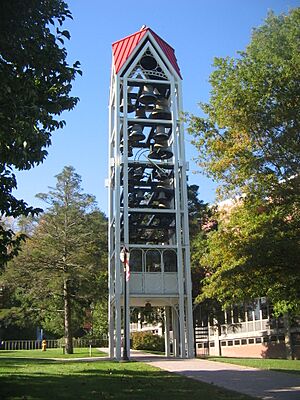
Lock Haven University of Pennsylvania offers public events like concerts, plays, and art shows. Millbrook Playhouse in Mill Hall also puts on plays. In the summer, there are free concerts in city parks. The local Jaycees group hosts a boat race (regatta) on the river every year.
The city also has fun festivals. Airfest happens at the airport in the summer. There are also parades for Halloween and the holidays. Pilots who love old Piper planes come to the city for "Sentimental Journey Fly-Ins" each summer. People who fly radio-controlled model airplanes also meet yearly at the William T. Piper Memorial Airport.
The main library for Clinton County is the Annie Halenbake Ross Library in Lock Haven. It has many books and other resources. The university also has its own library, Stevenson Library.
The Piper Aviation Museum shows airplanes, equipment, and photos related to Piper Aircraft. The Heisey House is a museum that looks like a home from the mid-1800s. It has collections from the Victorian era. This house is also home to the Clinton County Historical Society.
The Pennsylvania Historical and Museum Commission has placed special markers in Lock Haven. These markers tell about important historical places like Clinton County, Fort Reed, and the Pennsylvania Canal. The Water Street District, with its old buildings, and the Memorial Park Site, an ancient Native American site, are also important historical places.
Local media includes The Express newspaper and The Eagle Eye, the university's student newspaper. There are also radio stations WBPZ (AM) and WSQV (FM).
Parks and Recreation
Lock Haven has 14 city parks and playgrounds. They range in size from small Triangle Park to the large Douglas H. Peddie Memorial Park. The city has fields for baseball and softball leagues for kids and adults. In 1948, a team from Lock Haven won the Little League World Series. In 2011, another Lock Haven team, Keystone Little League, placed third in the United States Little League World Series.
Hanna Park has tennis courts, and Hoberman Park has a skate park. The Lock Haven City Beach on the Susquehanna River offers a sandy beach and a bath house. The city also runs a summer recreation program with the school district.
For outdoor fun, there's a 2.5-mile walking trail on the levee along the river. The local Young Men's Christian Association (YMCA) offers many programs. The Clinton Country Club has an 18-hole golf course in Mill Hall.
Education in Lock Haven
Schools for Younger Students
Keystone Central School District serves Lock Haven and much of Clinton County. This district was formed in 1970. Three elementary schools are in or near Lock Haven: Robb Elementary, Woodward Elementary, and Mill Hall Elementary.
Central Mountain Middle School in Mill Hall is the public middle school for grades six to eight. The public high school, Central Mountain High School, is also in Mill Hall. The district's main offices are at the high school. Lock Haven Catholic School is a private school for students from kindergarten to eighth grade.
Lock Haven University
Lock Haven University of Pennsylvania is located on the west side of the city. It covers 175 acres. The university offers many college programs and classes for adults. In 2023, about 2,500 undergraduate students and 400 graduate students attended the main campus. The university also has a smaller campus in Clearfield, about an hour west of Lock Haven.
City Services and Transportation
Getting Around Lock Haven
Lock Haven Taxi provides taxi services in the city. Fullington Trailways offers daily bus service to nearby cities like State College and Williamsport.
Pennsylvania Bicycle Route G passes through the area. There is also a 2.5-mile walking trail on the levee along the river.
The Norfolk Southern Railway's main line runs through Lock Haven, but it only carries freight (goods), not passengers. The city also has the William T. Piper Memorial Airport. This airport is for small, private planes and does not have commercial flights.
City Utilities
Electricity in Lock Haven comes from PPL Corporation. Natural gas is provided by UGI Central Penn Gas. Verizon Communications handles local phone service. High-speed internet is available from Comcast and River Valley Internet.
The City of Lock Haven owns the water system. It provides water to the city and nearby areas. The city also has a sewage treatment plant that handles wastewater from Lock Haven and eight other towns. Storm water is managed by city sewers. Garbage and recycling are picked up from homes. The Clinton County Solid Waste Authority runs the landfill for Lock Haven.
Famous People from Lock Haven
- Alison Bechdel (born 1960), a graphic novelist known for Fun Home
- John Sloan Dickey (1907−1991), a former president of Dartmouth College
- Brittani Kline, winner of America's Next Top Model Season 16
- Kermit V. Lipez (born 1941), a judge for the U.S. First District Court of Appeals
- Richard Lipez (1938−2022), an author who wrote mystery novels under the name Richard Stevenson
- Alexander McDonald (1832–1903), a former U.S. Senator from Arkansas
- Tom Poorman (1857−1905), a professional baseball player
- John Shaffer (baseball) (1864-1926), a professional baseball player
- George Smith Good (1844-1913), an industrialist and railroad builder
- John French Sloan (1871−1951), a famous artist
- C. J. Snare, singer and songwriter for the band FireHouse
See also
 In Spanish: Lock Haven para niños
In Spanish: Lock Haven para niños





